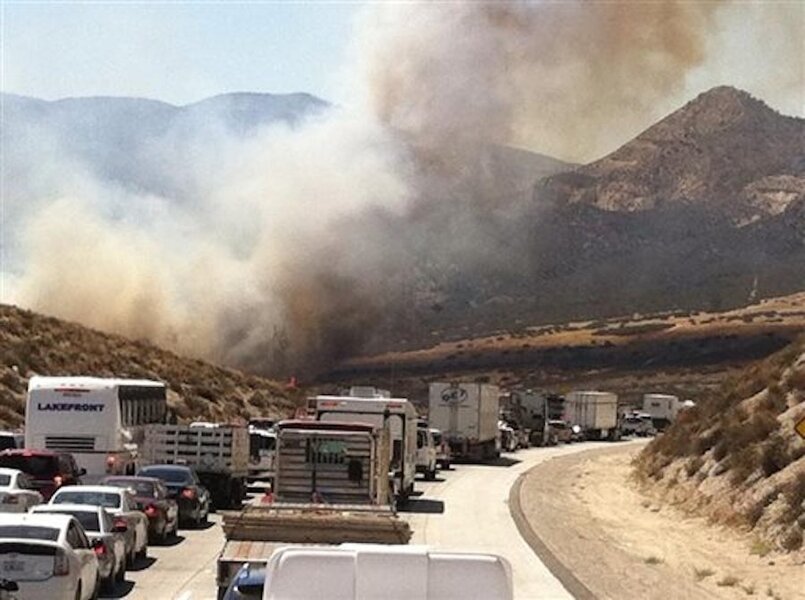Southern California wildfires: Why drones are a problem
Loading...
Motorists in Southern California watched (and some fled) as a massive wildfire swiftly burned through Interstate 15 in the mountainous Cajon Pass on Friday.
When fire officials initially rushed to contain the blaze, air support was stymied by aerial gawkers. After spotting five drones in the area, they were forced to halt flights by aircraft sent to extinguish the flames. At least 20 cars were destroyed in the fire.
The incident was the fourth time in a span of a month that a drone hindered efforts to contain a wildfire in Southern California, U.S. Forest Service spokesman Lee Beyer told the Associated Press. Officials grounded the firefighting planes for 26 minutes out of fear the planes would collide with the drones, ABC News reports.
The fire started at 2:30 pm on Friday and spread across 3,500 acres, requiring about 1,000 firefighters to suppress the flames. It destroyed more than a dozen vehicles on the freeway and at least four structures in Baldy Mesa, a nearby rural community. By Saturday, firefighters had only contained five percent of the blaze.
But rain and lower temperatures on Saturday, allowed some crews to be shifted to another blaze that forced hundreds of campers to evacuate, including a Girl Scout troop. Highway officials reopened most of Interstate 15.
California has been facing a severe drought, creating a greater risk of wildfires. Yet lawmakers are no longer willing to accept the delays drones impinge on firefighters’ efforts.
"As soon as we see drones, we shut down all of our aircraft for the safety reasons," said Mr. Beyer. "If a drone got sucked into a wing or a propeller, that could have some serious impacts."
The San Bernardino County Board will deliberate how to crack down on drone operators who may endanger the county’s citizens and public safety officials during its next meeting on July 28, reports the Sun Bernardino Sun.
It will also discuss how it can enforce existing laws on illegal drone use and possibly offer rewards for information that would help identify and convict illegal drone operators who disrupt firefighters and police during emergencies.
Similar efforts sprung up after the San Bernardino Mountains Lake Fire spread across nearly 30,000 acres in late June. According to Southern California’s The Desert Sun, the wildfire grew significantly after officials spotted a drone in the area and were forced to ground their aircraft for several hours, allowing flames to spread.
In response, California Rep. Paul Cook, (R) of Apple Valley, introduced the Wildfire Airspace Protection Act of 2015 on July 10. The act would make it a federal offense to launch a drone that interferes with fighting wildfires on federal land.
“I couldn’t believe it when I heard that aerial firefighting was brought to a grinding halt because a reckless individual decided to fly a drone over the Lake Fire,” Representative Cook wrote in his statement. “Not only did it put the lives of aerial firefighters in jeopardy, but the loss of air support for fire crews allowed the wildfire to spread.”
If the bill were to pass, it would exempt firefighters and other first responders who use drones for aerial firefighting. But anyone convicted under the act would face a fine and up to five years of prison, reads Cook’s statement.
Cook announced the federal bill as two state legislators launched a plan to criminalize drone use over a wildfire in California, the San Bernardino Sun reports.
Assemblyman Mike Gatto (D) of Glendale) and Sen. Ted Gaines (R) of El Dorado introduced Senate Bill 167 to toughen the current state law banning efforts that interfere with firefighters doing their jobs. The current fine for the misdemeanor is $1,000, but the proposed law would charge offenders much more for interfering, and would also consider jail time when a drone is used without permission.
“[Firefighters] are risking lives,” Assemblyman Gatto said. “Just because you have access to an expensive toy that can fly in a dangerous area doesn’t mean you should do it. If these folks are callous enough to risk others for the thrill of flying into a public safety emergency, we have to make sure we send a signal that our society won’t put up with it.”





